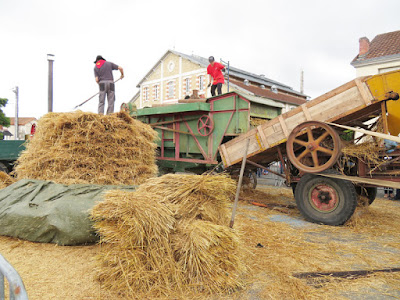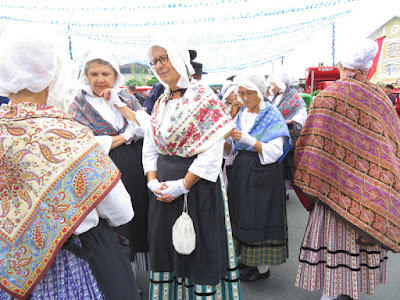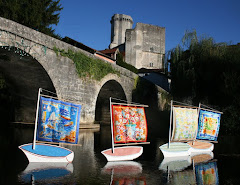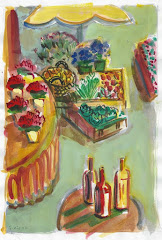Tuesday, December 26, 2017
Same Latitude, Same Celebration, But........
Dropping off my hot chocolate, Julian, our usually quiet cafe owner, hesitated.
“Susan.”
“Yes. “
“Do you always eat turkey for Christmas?”
I could tell he meant “you” as in all Americans. How could I answer for an entire nation?
My immediate thought was yes we do eat turkey, but then my brain said it’s not fair to say that everyone eats turkey. How far into family preferences or regional detail should I go? or should I just stick to the story book version of an American Christmas meal.
My quandary was solved when Julian said, “I watched a Christmas classic on TV last night. Is that what it is really like?”
Based on last nights holiday drama, and years of other shows like it, he had some very specific questions.
Here were his questions:
Where were the oysters?
Is the turkey always so big?
What do you eat with the turkey?
I didn’t see them serve the foie gras?
How about the cognac and armagnac?
What kind of cheeses do Americans like?
Like all of us Julian’s visual and taste references are based on his childhood memories. His family is 4 or 5th generation Bourdeilles and they have never ventured from the classic french Christmas dinner. Marriages have been with other local families so the holiday meal traditions are straight out of casting for a Perigordine feast.
Julian’s questions gave me pause. How could I balance gross generalizations with explanations of why a “typical” American family does not sit down to the same meal that a French family will.
Starting with the oysters I try to explain that most Americans live far away from the sea coast and that makes fresh oysters a delicacy that few families partake in. How could I demonstrate the space between Boston and somewhere in Montana to someone for whom a trip to Pairs, 6 hours away, is like going to the moon? Instead I said my family holiday meals got started with a good glass of whiskey and maybe some peanuts before we went in to table. Sometimes a little smoked salmon.
“But what about the oysters” Julian muttered. I could tell he loved his oysters.
Next was the question of the turkey? How could a family possibly eat a 12 kilo (25 lb) bird? I know it does not occur to him that there has to be left overs. France is a country that has yet to embrace sandwiches (outside the train station baguette with butter and ham). We laughed as I explained that my oven here would never be big enough for an American-sized turkey. His dubious smile suggests that he wonders if my kitchen is really that French.
The side dishes are what really got to him. Cranberries, sweet potatoes, mashed potatoes, green bean casserole, stuffing, rolls, vegetables vegetables…..
Where are the chestnuts, baguettes, leeks, cepe mushrooms…….?
And there was a gaping hole in the courses. Where was the foie gras? When does that appear on the table? How could I tell him that the chances of there being foie gras on an American’s Christmas table are about 1 in a million? No foie gras at a holiday meal is sacrilege to him, to his clan, to his Perigordine economy!
Dessert was sort of easier to sort out. Of course there is dessert, no cultural difference there, except I know that when I say apple pie he is picturing tart and when I say pumpkin pie he’s seeing weird. Who in your family knows the secrets of how to make the perfect traditional buche de noel?
He has worked he way through the courses, now for the hours of sitting back and relaxing…. What, it’s not automatic that you sit back from the table and have a cognac something to crown off your wonderful hours of eating? I figure most American families clock in about 2 to 3 hours around the table. Here your celebration has been a failure if you don’t spend at least 5 hours around the table.
Suddenly he realizes he hasn’t asked about the cheese course. How do I tell him that if we had cheese it would have been way back with the glass of whiskey? That course would have been some sort of cheese ball with crackers -- explain a cheeseball to a frenchman.
It was sweet how he wanted to understand what and how Americans would navigate a Christmas meal, but my explanations weren’t really sinking in. Several times he would ask his question again in a different way to see if maybe I’d give a different answer. Sometimes I’d try to rethink my answer to see if I could illustrate a point better or maybe generalize a little bit less, create a picture of my childhood traditions.
The last thing on Julian’s mind was how do Tom and I celebrate Christmas now that we are living in the heart of gastronomic eating? He was happy to know we would eat with a friend that is known for her expertise as a French cook. We would be set in our own Perigordine movie. Mostly Julian just wanted to be sure that there would be foie gras and that we would eat it! (Me, yes; Tom, no.)
(By chance this was the year that we had a tasting comparison of duck foie gras versus goose foie gras. We were split on preferences and reasons for them.)
Labels:
Bt,
Same Celebration,
Same Latitde
Tuesday, July 11, 2017
Felibrée Festival in the Perigord, La Dordogne, France
It takes a lot of semantic wandering to arrive at where we live in France. Tumbling down this road, we live in the Nouvelle Aquitaine, the Dordogne, the Perigord, the Perigord Vert, and finally the village of Bourdeilles. It’s way too complicated to explain, but this is sort of the French version of region, state, county, city. France now has 13 regions each with strong regional traditions. The language and cultural traditions of the Perigord are celebrated each year at the Felibrée Fair
Not too long ago most of the locals in our village did not speak French. They spoke a sort of patois that is called Occitan or langue d’oc. It actually wasn’t just our village, but all of southern France, each with their own nuances of patois. My neighbor remembers having her knuckles rapped by her teacher if she was caught speaking to her classmates the patois she spoke at home. Into the 1950s France was in the process of erasing this old language and having “French” be universal.
There were always those that wanted to preserve the old language and some of the traditions that were associated with this southern culture. Eventually they organized an annual fair and conferences. There are now courses in school for the language, language clubs sprinkled around the different villages, and folk groups that carry on the traditional dress, music and dance.

Once a year all things Occitan are celebrated at this grand Felibrée. This vivacious fair is held in a different location each year showing off the beautiful corners of the Perigord.
The Felibree is hosted by a different city or village each year. The decorations are unlike anything you will see anywhere at any time other than in that village for the four days of the fair. Pride of place is important, but it is also the work behind that scenes that perpetuates a sense of place. It takes 500 worker bees all winter to make the 130,000 artificial flowers that will then be strung into garlands to hang above the celebrations in the streets of this years showcase community. There are usually anywhere from 5 - 10 neighboring villages or hamlets that take part in this massive work load. These communal hours spent together before the Felibrée are as important as the event itself. Winter is the time that communities gather together, folks sit for hours on end chatting while their hands work towards a common goal.
There will be dances, lectures, demonstrations of how things used to be done - children gasp to see laundry washed in buckets and wrung out by fingers turning to prunes, there will be bike decorations and mountains of food to be eaten, music and dancing and beautiful costumes, books to buy written in the old language - even a church service conducted in Occitan, t-shirts to buy and more dancing. It’s a fair!
f
Labels:
Festival in the Perigord,
France,
La Dordogne
Friday, June 16, 2017
Subscribe to:
Posts (Atom)



















































































